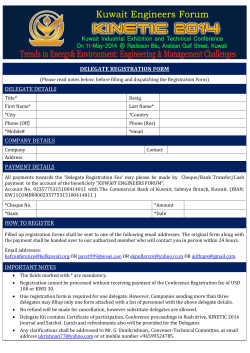
Committee Hearing Procedures ECOSOC/GA
Committee Hearing Procedures ECOSOC/GA Introduction of Topic by Committee Chair Every committee will work off the assigned topics and Topic Preparation Guides. Each delegate will have one position paper per topic addressing TPG questions and Operative & Preambulatory clauses for a Resolution on the topic. Opening Statements by all Member countries (1 minute each) Using their position papers delegates will be able to share their country’s stance on each topic. This is an opportunity for a delegate to provide information, research, and their country’s cultural views. Formal Debate via the Speakers List (2 minutes each) The Committee Chair will take down a list of volunteering delegates to speak on a topic. Each delegate will have 2 minutes. If a delegate makes any accusations toward another country the delegate from the accused country gets a right of reply for 1 minute. Delegates may motion for the Speakers List to be expanded and/or reopened. The Committee Chair ultimately decides on whether to entertain the motion for a vote. Motion for start of Informal Debate/Caucusing for a determined length of time The Committee Chair will set a time limit for informal debate and may extend informal debate if there is no objection. Once time has expired, a motion to resume Formal Debate on a proposed Resolution must be made. Informal debate is not moderated by the Committee Chair; delegates may speak freely and caucus with other members of the committee to start drafting a Resolution on a topic using points from formal debate speeches, the prepared Operative & Preambulatory clauses, and evidence/research. Motion for Formal Debate on a proposed Resolution via the Speakers List (2 minutes each) The Committee Chair will call for a new Speakers List. Delegates will have 2 minutes to speak on their country’s stance of the proposed Resolution, makes points of clarification and/or suggest amendments. Motion to vote on or amend the Resolution Once all delegates on the Speakers List have been given time to speak the Committee Chair will ask for a motion on the Resolution. There are two types of motions: 1. VOTE ON – The committee votes on whether to pass the resolution or not. 2. AMEND – A delegate motions to change part of the Resolution. If the motion is to Amend the Resolution, the amendment is introduced and the process returns to step 3, informal debate and continues until a motion to Vote On the Resolution is reached. A resolution either passes or fails After a motion to VOTE ON the Resolution, the Committee Chair will ask for a vote by a show of hands from the Committee. If a Resolution passes, it moves on to the Plenary Session. The Secretariat will provide a final draft of the Resolution to the Office of the Secretary General for processing.
© Copyright 2025
















